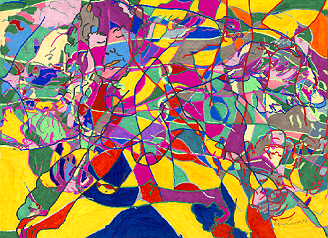
The modality of a television program is the measure of closeness to the real that the program portraits. News is high modality while cartoons are low modality. This concept should not be confused with the mode of media consumption.
The parameters for modes of consumption are: Venue, number of participants, division of attention, power situation within the consuming group, segmentation, level of leisure and spatial relationship. These seven parameters are by no means mutual exclusive, orthogonal or independent.
There is much discussion about how children consume television and the various relationships adults create for managing these situations. There is some discussion about the relationships pertaining to the mode of consumption and popular discrimination.
When we have the 'family' viewing there is one to four adults, one to six teens, zero to four children and now maybe a baby. Technical magazines often are easy to share. Contrarily, books are not easy to share. I believe that the ability to stay in sharing mode is bounded in the time dimension. The magazine is a quick read while the book takes forever. Radio as background gets a lot of sharing. Recorded music is also in the background but often it is the subject of discussion for a small group.
I often have the position of leader in information consumption events. I have tried to moderate my dictatorial natures to provide alternate input. For video watching, we open with a documentary and then have the feature. The burden of choice for documentary usually falls on my shoulders while others push the on my shoulders while others push the feature. Radio station listening should minimize commercials and shouting. Repetitive play of recorded music is discouraged excepting for rehearsals or programming purposes. I often subject myself to an education venue where others direct some of my consumption.
My attention is seldom focused on one thing. The occasional visit to the theater, cinema or concert hall provides those occasions. For me there are at least three distinct states: 1) the text is boring and sleep prevails 2) the text offers some merit and magazine flipping, coloring or doodling sustains alertness 3) the text heavily engages me and I start constructing mental imagery. I notice that my immediate family tend to multi process while friends tend to focus or even time slice.
When the information is presented in a time based media, I tend to fanatically rebel against segmentation. I don't particularly enjoy intermission and I detest television ads. If meaningful dialogue develop during the breaks then they are bound by time limits. The segmentation of a magazine does not bother me. In fact, I enjoy the j I enjoy the juxtapositions.
Generally the consumption of information is considered serious for me and in varying degrees within the family. This comes from the opportunities to discuss and relate to the texts. The mindless offering can be approached by questions like: What was the most profound idea in the work? What does this work say about the society (or watchers) of it? How would you improve this work? Since there is a lot of consumption of information in my life, I attempt to keep it relaxing and enjoyable.
I enjoy the tactile nature of print. The intimacy of the book on my lap is why I still invest so much time and money into this form of information. The close spatial proximity lends to embracing the content. In the case of video I notice that eye condition (what works for the glasses/contacts or lack of) is the most dominant condition. This seems to be followed by the rule of little one to the front. I personally stay three or more meters from meters from the screen. By the way, video editing is done with less than a meter distance. Recorded sound is best enjoyed in a large (even outdoor) space at a good volume (since I am slightly hearing impaired).
So, do these observations indicate a management strategy of information consumption? For an unconscious strategy, I believe they do.
Page Created March 10, 1998
Page Last Updated April 2, 1998